Solo Queue vs Flex: Key Differences & Which to Choose in League of Legends
Updated On: November 12, 2025 by Aaron Connolly
Understanding Solo Queue
Solo queue is League of Legends’ main competitive mode. You play alone or with just one friend to climb the ranked ladder.
You have to reach level 30 and own at least 16 champions to get in. This system sorts players into skill-based tiers, so you always play with and against people near your level.
Eligibility and Access
To get into solo queue, you need to hit level 30 on your account. That usually takes anywhere from 50 to 80 hours, depending on how much you play.
You also need at least 16 champions unlocked. Riot set this up so you can draft flexibly and fill different roles. Most folks just grab the cheapest champs first to hit that number.
Quick tip: It’s way better to focus on a couple of roles and champs you actually enjoy, rather than spending all your Blue Essence on random picks.
Once you meet the requirements, you can queue up solo or with one friend. Riot doesn’t let you queue as three or five—keeps things fair and more about individual skill.
The system matches you with eight other players at a similar skill level. Queue times range from about 30 seconds to 5 minutes, depending on your rank and server.
Ranking Structure and Ladder
Solo queue uses nine main tiers to sort everyone by skill. From bottom to top, you’ve got Iron, Bronze, Silver, Gold, Platinum, Diamond, Master, Grandmaster, and Challenger.
Most tiers have four divisions (IV, III, II, I). Gold IV sits at the bottom of Gold, while Gold I is just before Platinum. The top three tiers—Master, Grandmaster, and Challenger—don’t have divisions.
Your placement matches set your starting rank. After you hit level 30, you play 10 games, and the system figures out where you belong. Most people start in Iron or Bronze.
| Rank Tier | Divisions | Approximate Player % |
|---|---|---|
| Iron-Bronze | IV-I each | 35% |
| Silver | IV-I | 25% |
| Gold | IV-I | 20% |
| Platinum+ | IV-I / No divisions | 20% |
Each season lasts about a year. At the end, Riot partially resets everyone’s rank, so you get a fresh shot at climbing.
Game Format and Experience
Solo queue matches always take place on Summoner’s Rift, the classic 5v5 map. Games usually last 25-35 minutes, and you can surrender at 20 if things go south.
Draft mode lets both teams ban and pick champs. You get assigned to Top, Jungle, Mid, ADC, or Support. Support queues fill up fastest, while Mid usually takes the longest.
Solo queue is seen as the most competitive mode. People care a lot about their individual rank, so the games can be sweaty—and sometimes toxic. You’ll chat and ping with strangers most of the time.
Your matchmaking rating (MMR) decides who you play against, not just your visible rank. If you go on a win streak, you’ll climb faster; if you lose a lot, the system might match you with lower-ranked players to help you bounce back.
At the end of the season, you can earn exclusive skins, borders, and icons, depending on your rank. Hitting Gold or higher unlocks the annual Victorious skin, which is always a nice flex.
Exploring Flex Queue
Flex queue lets you team up in groups of 1, 2, 3, or 5 and play ranked together. It uses the same rank structure as solo queue, but it’s a totally separate ladder with its own vibe.
Team Composition and Party Sizes
Flex queue supports pretty much any group size except four. Riot blocks four-stacks to avoid dumping a solo player into a team of four friends—nobody wants that.
You can queue as:
- Solo player (matched with other solos or small groups)
- Duo (two friends)
- Trio (three-person premade)
- Full team (five friends)
This opens up a lot of options. Solo players often get paired with duos or trios, and full five-stacks can coordinate much better than randoms.
Quick win: If you’re new, flex queue is a chill place to start. The atmosphere is usually less intense than solo queue.
Flex Ranking System
Flex queue uses the same tier ladder as solo queue but keeps the rankings totally separate. You might be Diamond in flex and just Gold in solo, and that’s normal.
The tiers go from Iron through Diamond (each with four divisions), then Master, Grandmaster, and Challenger at the top.
Rank restrictions kick in once you finish placements. You can only queue with friends who are close to your own rank. For example, a Gold 1 can’t queue with a Silver 2.
During placements, though, you can play with anyone, no matter the gap. Once you get your rank, that freedom is gone.
Origins and Development
Riot rolled out flex queue in Season 7 to replace the old ranked 5v5 team system. The old way forced all five team members to be online at once, which was a scheduling nightmare.
Flex queue fixed that by letting smaller groups play ranked together. You no longer need your whole squad online just to grind some games.
Riot wanted to make a middle ground between solo play and full team coordination. Flex queue gives friends a way to climb together without the strict rules of the old system.
Warning: A lot of people treat flex as less serious than solo queue. If you’re looking for high-stakes games, flex might not always deliver.
Main Differences Between Solo Queue and Flex
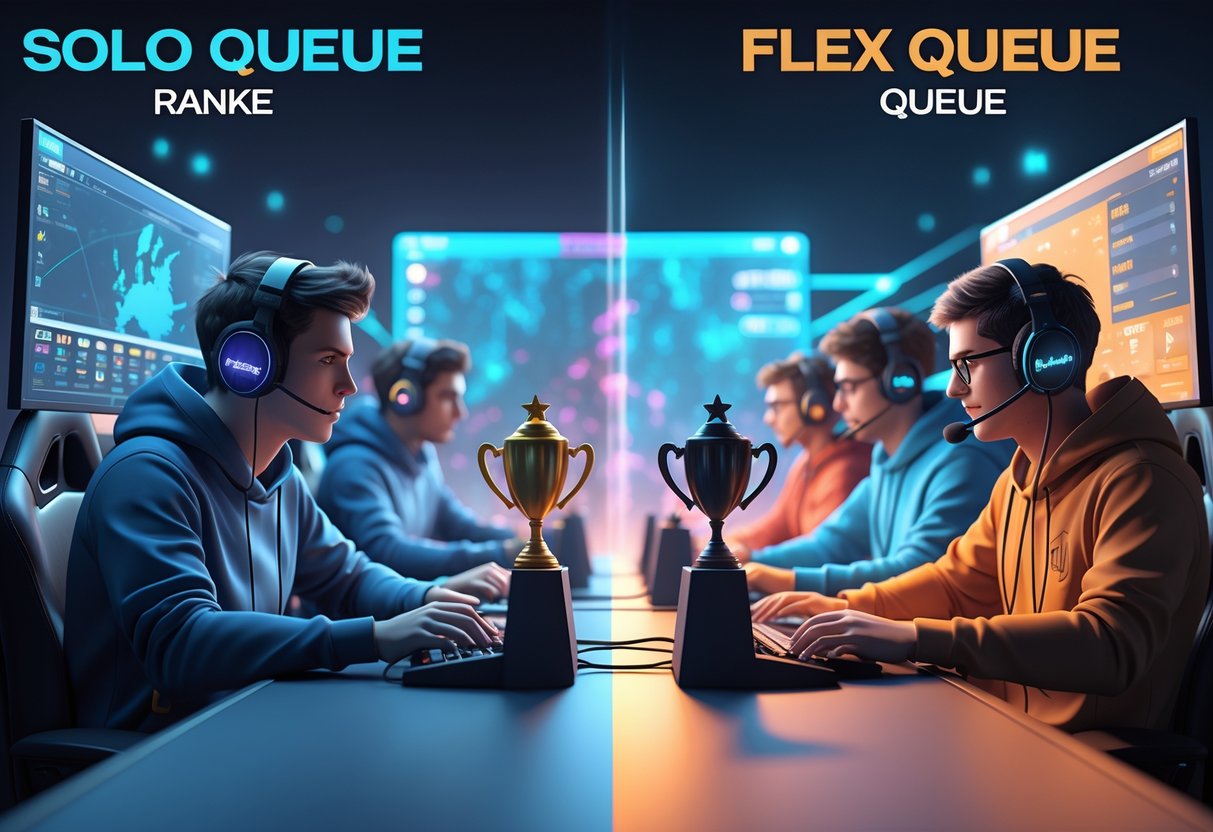
Solo queue and flex run on separate ranking systems. They have different group sizes, progression, and matchmaking. That really shapes how you experience ranked play.
Queue Size and Group Options
Solo queue only lets you play alone or with one friend. It’s all about individual skill and your own decision-making.
Flex queue is way more open. You can queue as:
- 1 player (solo)
- 2 players (duo)
- 3 players (trio)
- 5 players (full team)
No four-stacks allowed in flex. Riot blocks them to avoid one poor solo player being thrown into a coordinated group of four.
This setup changes team dynamics a lot. In solo queue, you rely on strangers who might not talk or cooperate. In flex, you can actually pull off real strategies if you have a squad.
Ranking and Progression
Your solo and flex ranks are totally separate. You might be crushing it in flex but just average in solo queue.
Each queue has its own:
- MMR (matchmaking rating)
- Seasonal rewards
- League placement (Iron through Challenger)
- Win/loss history
Rank restrictions work differently. In flex, after placements, you can only group with players close to your rank. A Gold can’t queue with a low Silver or below.
People generally see solo queue as the more prestigious mode. Most pros and streamers focus on solo queue when talking about skill.
Matchmaking Processes
Solo queue matchmaking focuses on individual skill. The system tries to build teams where each player’s personal performance is the main factor.
Flex matchmaking takes premades and team coordination into account. If you’re a trio on voice, the system tries to match you against another coordinated group.
Queue times can be pretty different. Solo queue usually pops faster since it’s just looking for ten solo players. Flex, especially for big groups, can take longer while the system searches for balanced teams.
The skill gap can feel wider in flex. Some players treat it like a warmup or just a place to mess around, so you might run into opponents who are much better—or worse—than their flex rank suggests.
History and Evolution of Ranked Play

League of Legends ranked changed a lot before Riot brought in solo and flex queues. The biggest overhaul came in Season 7, when they ditched the old team-based system.
Ranked Modes Before Season 7
Before Season 7, League offered Solo/Duo Queue and Ranked Team Queue.
Ranked Team Queue forced you to have five players ready to go. That setup just didn’t work for a lot of folks.
Teams had to get everyone online at the same time, or you couldn’t play. If one person bailed, the whole team was stuck.
Problems with the old system:
- Needed all five players every time
- No way for smaller groups to play ranked
- Teams broke up when people had different schedules
- Three or four friends couldn’t play ranked together
It worked for organized teams, but casual groups had no real options. People wanted to play competitively with friends, but couldn’t always get a full squad.
Introduction of Flex Queue
Riot launched Flex Queue in Season 7 to replace Ranked Team Queue. This new system fixed a lot of headaches.
Flex Queue allows:
- 1 player (solo)
- 2 players (duo)
- 3 players (trio)
- 5 players (full team)
No four-stacks, though. Riot blocks them to keep things fair for solo players.
Flex Queue gave players way more flexibility. Now, three friends could queue up without scrambling to find two more.
Flex runs on the same ranking system as Solo/Duo, but your ranks don’t cross over.
Riot’s Influence on Ranked Queues
Riot made these changes after listening to player feedback and studying how people actually played. They saw that lots of players wanted to compete with friends, but the old team system just didn’t fit their lives.
Riot’s key decisions:
- Separate ranks to avoid boosting problems
- Rank restrictions to keep premades fair
- Solo/Duo stays the “main” ranked mode
Riot made Solo/Duo the main competitive ladder. Most players take it more seriously than flex.
They also added rank restrictions in Flex. You can only group with players near your rank, which helps keep games fair.
These rules stop high-rank players from carrying low-rank friends up the ladder. But let’s be real—sometimes the restrictions feel too strict if your friends are all over the place in skill.
Matchmaking Systems Explained
Solo Queue and Flex Queue each use their own MMR (matchmaking rating) system. Riot calculates your skill separately for each queue, based on how you play in that specific mode.
Solo Queue MMR Mechanics
Solo Queue matches you based on your personal performance. The system checks your MMR and tries to pair you with players at a similar level.
When you queue solo or with one friend, matchmaking looks at both your MMRs. Your solo rank shows your individual skill, not how well you work with a premade.
The MMR calculation uses a few factors:
- Win/loss ratio – win more than you lose, and your MMR goes up
- Consistency – win streaks boost your rating faster
- Opponent strength – beating higher-rated players gives you more MMR
Riot keeps the exact formula under wraps, but in solo queue, your own performance matters most.
Flex Queue MMR Systems
Flex Queue handles MMR differently because it cares more about how your team performs than your solo skills.
The system just averages your team’s MMR to match you with similar groups.
Here’s how team MMR works:
Say your five-player squad has MMRs of 1300, 1500, 2000, 2500, and 2100. Add those up (9,400), divide by five, and you get a team average of 1,880.
Matchmaking then looks for other teams with roughly the same average.
You might end up against opponents with wildly different individual ranks, but as long as the team average matches, the system is happy.
Playing with higher-ranked friends can really boost your MMR gains.
When your group beats a team with a higher average MMR, you all earn more rating points than usual.
Your Flex Queue MMR stays totally separate from Solo Queue.
If you bomb in one mode, it won’t mess up your rank in the other.
Advantages of Solo Queue
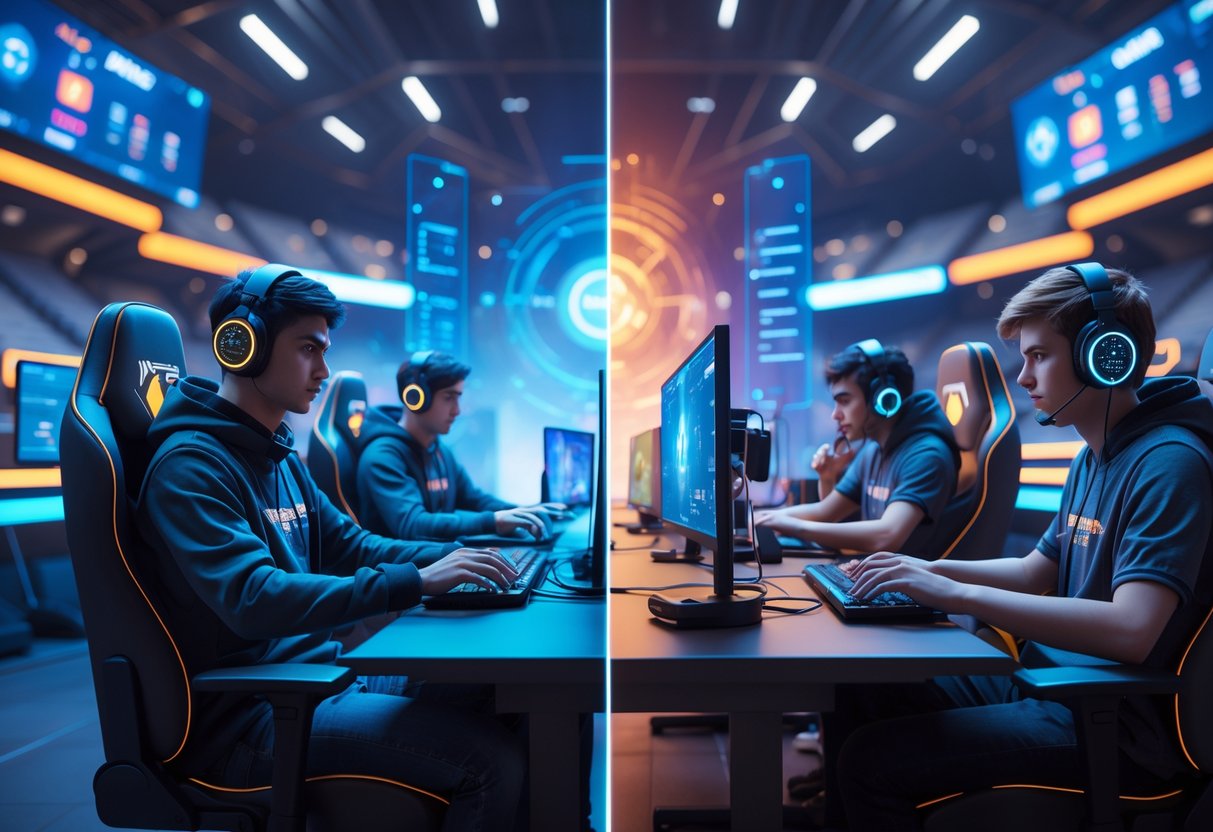
Solo queue is where you really put your individual skills to the test in League of Legends.
It’s where you grind for improvement and face the toughest competition on the main ranked ladder.
Personal Skill Development
Solo queue makes you develop skills that premade teams sometimes hide.
You have to adapt quickly to new playstyles because every match throws you in with different teammates and approaches.
Communication gets tricky when you can’t rely on voice chat with friends.
You’ll get good at pinging and typing, which actually builds leadership skills as you try to guide strangers to objectives.
Your decision-making improves fast in solo queue.
Without set team strategies, you have to read the game and make snap calls.
These moments force you to trust your instincts and test your knowledge.
You’ll also get a real sense of your own skill.
Solo queue removes the safety net of friends carrying you—each win and loss is on you.
Climbing the Main Ladder
The solo/duo ranked ladder is the main achievement system in League.
When people talk about rank, they’re almost always talking about solo queue.
Employers and esports orgs look at solo queue ranks first.
Pro teams mainly scout high-ranking solo players, and your solo queue rank is basically your competitive gaming CV.
Matchmaking feels more predictable in solo queue.
You face people with similar skills, not clashing groups with weirdly mixed ranks.
Progress feels more satisfying because you earn every promotion yourself.
No one can carry you up the ladder—your rank is all about your own grind and growth.
Advantages of Flex Queue
Flex queue brings some perks solo queue just can’t touch.
You get to play with friends and actually build teamwork skills that matter in real competitive League.
Playing with Friends
The best part of flex queue? You can queue up with your friends—1, 2, 3, or all 5 of you.
This means no more rolling the dice with random teammates.
You don’t have to worry as much about toxic players or awkward communication.
Quick tip: Try starting with just one friend to get used to coordinated plays, then add more as you go.
Losing with friends doesn’t feel as bad.
Even if you drop a game, you’re still hanging out and having a laugh.
You can also help newer players get better in a safer environment.
Teaching your bronze buddy how to ward is way easier when you’re both on voice.
Heads up: Try not to queue with friends who are way above or below your rank, or you’ll probably run into weirdly unbalanced games.
Teamwork and Coordination
Flex queue teaches you team skills that solo queue mostly ignores.
You learn to shot-call, control objectives, and teamfight as a unit.
Voice chat changes everything.
You can call ganks, share cooldowns, and react together in real time.
This practice actually helps in solo queue too.
If you get team play, you climb faster because you know when to follow calls.
Classic example: Your duo wants to rush Baron while you’re farming bot.
In solo, you might miss the chat ping, but in flex, you hear it and react instantly.
Pro teams use these same skills.
Flex queue lets you practice team comps, champion synergies, and even invent your own strats.
The strategic depth goes way beyond solo queue.
Drawbacks of Solo Queue
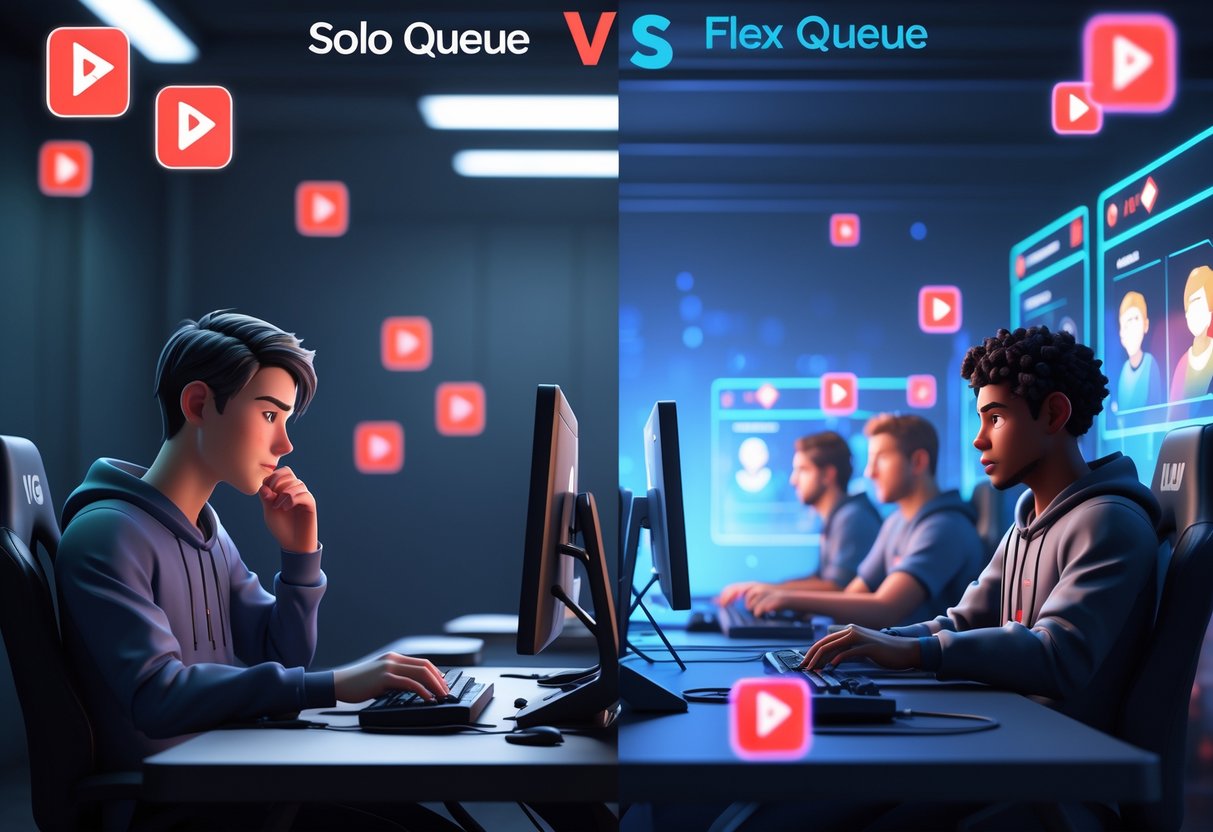
Solo queue comes with some tough downsides that can mess with your experience and mental health.
The lack of coordination and anonymous matchmaking can make things pretty toxic.
Toxicity and Stress
Solo queue often brings out the worst in people.
You’re stuck with strangers who don’t care about you or their own reputation.
People vent with verbal abuse, trolling, or even feeding on purpose.
Because matchmaking is anonymous, toxic players rarely face consequences.
They flame teammates knowing they’ll probably never see you again.
Common toxic stuff:
- Verbal abuse in chat
- Griefing or trolling
- Blaming others for losses
- Rage quitting
Stress piles up because your rank depends on team results.
You might play out of your mind and still lose because someone on your team tilts.
That frustration adds up after a few games.
A lot of players say solo queue leaves them mentally drained.
The pressure to perform, plus wild teammates, can suck the fun out of the game.
Reliance on Unknown Teammates
Solo queue makes you trust total strangers with your rank.
You never know if your team will communicate, pick their best roles, or even try to win.
Matchmaking tries to balance things, but it can’t predict when someone’s off-role or testing a new champ.
Game quality swings all over the place, and it’s out of your hands.
Main issues:
- Teammates picking random champs
- Weak communication
- Different game knowledge
- Some people just don’t care
Sometimes you face duos with perfect synergy while your team is five solo players.
That puts you at a disadvantage, no matter how good you are.
It’s hard to build up strategies or chemistry.
Every game feels like a fresh start with a new set of wildcards.
Drawbacks of Flex Queue
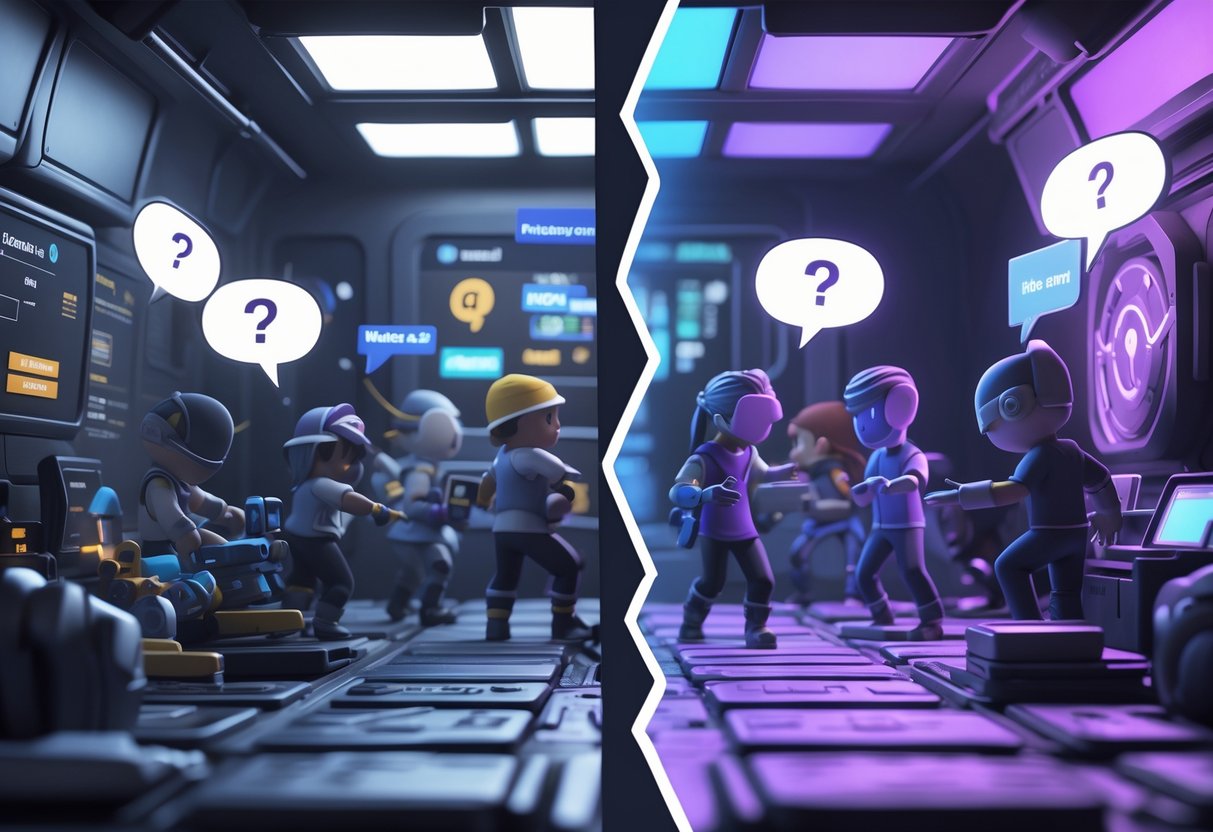
Flex queue has its own headaches.
Matchmaking can feel unbalanced, and most players don’t treat flex ranks as real achievements.
Matchmaking Imbalances
Flex queue’s biggest problem is how it puts teams together.
The system struggles when different group sizes queue up at once.
You might end up solo against a full five-stack with voice comms and set tactics.
Your team could be three strangers and a duo, so coordination is all over the place.
Matchmaking issues:
- Solo players vs premades
- Big skill gaps in groups
- Off-role picks
- Messy team synergy
Flex queue mixes player skill more loosely than solo.
A Master player can queue with Gold friends, so you get wild skill differences.
Some games feel like a stomp, others are impossible because of team comp mismatches.
It can feel like a coin flip.
Perceived Competitive Value
Honestly, most of the community doesn’t take flex queue seriously.
Solo queue is what counts for skill.
Why flex ranks don’t impress:
- You can get carried by better friends
- Lower competition
- Some use it just to practice or chill
- Easier to boost rank in groups
Pros and coaches care way more about solo queue.
Flex achievements rarely count for recruitment or reputation.
The chill vibe is great for learning, but your rank doesn’t mean much competitively.
A Platinum flex player might still struggle in Gold solo queue.
Ranked Ladder Progression and Rewards
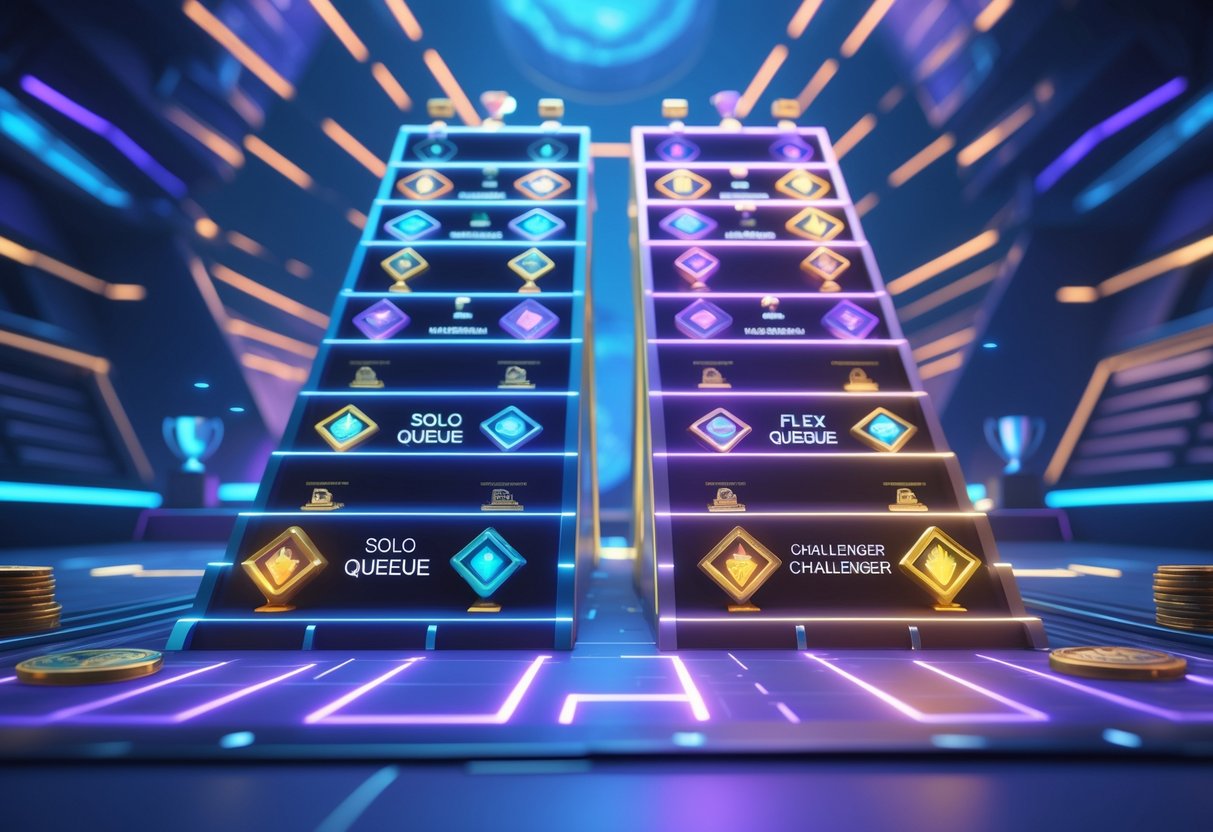
Solo/Duo and Flex each use the same ranking system but have their own rewards and progression.
Your rank in one doesn’t affect the other, and rewards stay separate too.
Differences in Rewards
Solo/Duo rewards are the big prize in League.
At season’s end, Riot hands out exclusive skins, borders, icons, and emotes based on your highest rank.
These rewards have more prestige.
Most people grind Solo/Duo for the better loot and status.
Flex queue rewards work the same way, but they’re totally separate.
You can earn different prizes for your Flex rank, even if it’s higher or lower than your Solo/Duo rank.
So, if you hit Diamond in Flex but only Gold in Solo/Duo, you get Diamond rewards for Flex and Gold for Solo/Duo.
| Queue Type | Reward Priority | Community Value |
|---|---|---|
| Solo/Duo | High | Most prestigious |
| Flex | Medium | Less recognised |
Ladder Reset Policies
Both ladders reset every year at season’s end—usually around November.
Everyone gets a fresh start.
When the reset drops, your rank falls in both queues.
You’ll need to play 10 placement games in each to get a new starting rank.
The reset hits both ladders the same way.
Your Solo/Duo and Flex ranks both drop, but they reset separately.
You keep last season’s rewards for good.
Once the new season starts, everyone climbs again from their new placements.
Choosing Between Solo Queue and Flex Queue
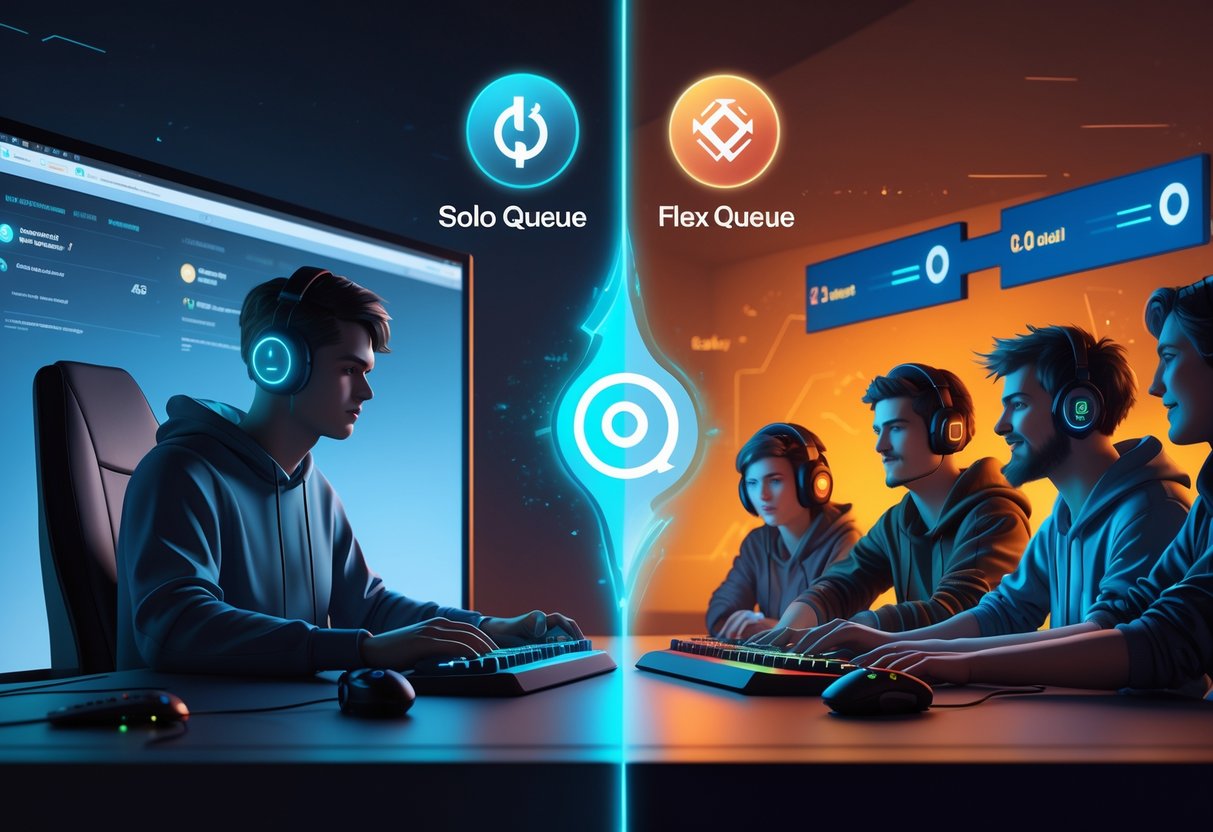
The choice between solo and flex queue really depends on your gaming situation and what you’re aiming for.
It comes down to whether you like playing solo or with friends, how seriously you take ranked, and what skills you want to build.
Factors to Consider
Your Gaming Setup
If you usually play League of Legends alone, solo queue just makes sense. You can hop into games whenever you feel like it, no need to wait around for anyone. Solo queue really tests your individual skills, too.
Flex queue suits you better if you often play with a group of friends. You can queue up with 1, 2, 3, or 5 players (but weirdly, not 4). That setup lets you focus on team coordination and communication.
Skill Development Goals
Solo queue throws you into games with different teammates every time. You’ll get better at adapting and sometimes carrying games solo. The competition feels tougher since people take solo queue more seriously.
Time Commitment
Solo queue gives you the freedom to play whenever. You don’t have to juggle anyone else’s schedule. Flex queue, on the other hand, means you need to plan with your team, which can get tricky if everyone’s busy.
Rank Restrictions
Flex queue puts strict rank limits in place after placements. You can only team up with friends who have similar ranks. For example, a Gold 1 player can queue with Silver 1 or higher, but not Silver 2 or below.
Personal and Competitive Goals
Competitive Ambitions
Most esports pros and hopefuls focus on solo queue. It’s the “main” ranked ladder in League of Legends. If you want to climb to the top or get noticed, you’ll need to prove yourself in solo queue.
Gaming expert James Connolly points out that solo queue gives the best measure of individual skill. You can’t just rely on coordinated strats with the same group.
Social Gaming Experience
Go for flex queue if you want a more chill ranked session with friends. Players there tend to be less toxic and more focused on having fun, even while trying to win. It’s a nicer vibe for learning without all the solo queue pressure.
Skill Building Priorities
Pick solo queue if you care about improving your mechanics, decision-making, and adaptability. You’ll face all kinds of playstyles and team comps.
Choose flex queue to get better at team coordination, voice comms, and group strategies. Playing with the same people helps you figure out team dynamics.
Frequently Asked Questions

A lot of players wonder about the real differences between these two ranked modes. How will your experience actually change depending on the queue you pick? Here are some answers about teamwork, difficulty, and climbing in each mode.
What are the main differences between playing in Ranked Flex and Solo Queue?
Solo Queue lets you play alone or with one friend. You’ll always face strangers and rely mostly on your own skill to move up.
Flex Queue allows groups of 1, 2, 3, or 5 players to queue together. You can’t queue as a group of 4, for whatever reason Riot decided.
Your rank in Solo Queue doesn’t affect your Flex Queue placement, and vice versa. They’re totally separate ladders.
Most people treat Solo Queue as the main competitive mode, so it usually feels more intense.
How does teamwork differ in Solo Queue compared to Flex Queue?
In Solo Queue, you have to coordinate with strangers. You’ll use pings and chat to get your point across, sometimes with teammates you’ll never see again.
Teams often struggle to coordinate since everyone communicates differently. Some folks just don’t talk at all.
Flex Queue lets pre-made teams use voice chat apps like Discord. That makes coordination and planning way easier.
When you play Flex with friends, you already know each other’s playstyles. You can actually develop team strategies over time.
Is it true that Ranked Flex is generally considered easier than Solo Queue?
A lot of players think Flex Queue feels less stressful than Solo Queue. The vibe tends to be more relaxed, especially if you’re with friends.
But skill levels in Flex can be all over the place. Sometimes you’ll run into players who are much higher ranked in Solo but just messing around in Flex.
Some matches get unbalanced when a coordinated team faces a bunch of solo players. A well-organized group definitely has the edge there.
People say Flex is “easier” mostly because there’s less pressure, not because the skill requirements are lower. Players often try out new champs or weird strategies in Flex.
What should I expect in terms of communication and coordination when participating in Ranked Flex?
Pre-made teams in Flex Queue usually hop on voice chat for real-time coordination. That lets you pull off complex strategies and make quick calls during fights.
If you play solo in Flex, you might end up with teams already on voice together. That can make you feel left out when they make decisions.
Communication quality really depends on your team makeup. Full pre-mades coordinate well, but mixed groups often struggle.
You’ll probably see more organized team fights and better objective control in Flex matches. Teams can plan baron and dragon fights more effectively.
Can you climb tiers and leagues at the same pace in both Ranked Flex and Solo Queue?
Your climbing speed mostly comes down to your own skill, not the queue. Both modes use similar ranking systems and promos.
Solo Queue usually feels more consistent for improving as an individual. Your performance has a direct impact on every match.
Flex Queue can move faster if you’ve got a solid team. Good teamwork lets you win even if your mechanics aren’t perfect.
Rank restrictions in Flex might slow things down if your friends are at different skill levels. You can’t play together if your ranks are too far apart.
How does one’s experience in Solo Queue translate to performance in Ranked Flex?
If you’ve honed strong individual mechanics in Solo Queue, you’ll probably notice they carry over to Flex matches. Your laning skills and champion knowledge still matter a lot.
But Flex throws in a twist. You have to shift from just carrying games by yourself to figuring out how to help your team win.
Map awareness from Solo Queue? It actually gets even more valuable in Flex. When you call out info, a coordinated team can jump on those opportunities way faster.
Maybe the trickiest part is learning to trust your teammates. Solo Queue kind of forces you to rely on yourself, but Flex really rewards players who help their friends shine.

